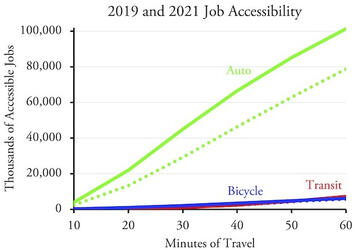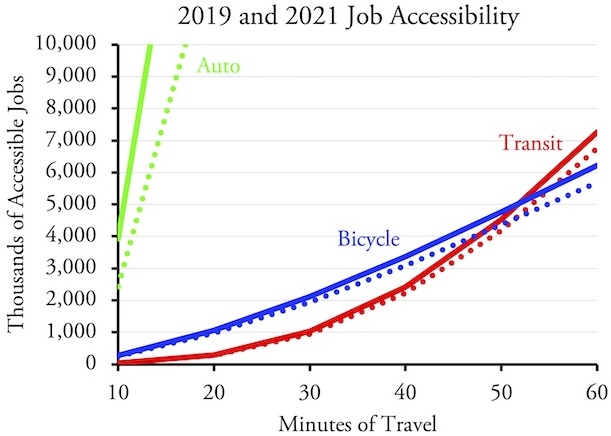
Data published by the University of Minnesota Accessibility Observatory a few months ago reveals some of the benefits of congestion relief that resulted from the COVID pandemic. I’ve used 2019 data in the past to show that residents of U.S. urban areas can reach far more jobs in a 20-minute auto drive than a 60-minute transit trip. The latest data for 2021 reveal that the number of jobs reachable by transit or bicycle was about 9 percent greater in 2021 than 2019, but the number reachable by a 20-minute auto drive was 66 percent greater.
These numbers are the average of the nation’s 50 largest urban areas, but for some the increased access caused by less traffic was much greater. In a 20-minute auto drive, residents of Atlanta, Boston, Los Angeles, San Francisco, San Jose, and Washington could reach more than twice as many jobs in 2021 than in 2019. Of course, jobs are only one possible set of destinations that became more accessible; other social and economic opportunities also became equally more accessible.

Transit riders were able to reach only 7 percent more jobs and bicycle riders 9 percent more in 2021 than in 2019. Solid lines show 2021 and dotted lines show 2019.
The Texas Transportation Institute documents that congestion in U.S. urban areas dramatically rose between 1982 and 2019. The average number of hours of delay imposed on individual commuters grew by nine times. This growth was because many cities had made a deliberate decision not to try to relieve congestion under the argument that increased capacity simply leads to more driving.
The response to this should have been: So what? Very little driving is frivolous. Instead, most of it is people trying to get to work, school, shopping, health care, friends and relatives, or recreation activities. Then there are trucks moving freight, bringing construction materials and services to work sites, and so forth. Anything that results in more such travel is a good thing because it means more economic activity, more income for people, and more access to better housing, lower-cost consumer goods, and other benefits. The sign of failure is if the new road capacity isn’t used, not if it is.
Read the rest of this piece at The Antiplanner.
Randal O'Toole, the Antiplanner, is a policy analyst with nearly 50 years of experience reviewing transportation and land-use plans and the author of The Best-Laid Plans: How Government Planning Harms Your Quality of Life, Your Pocketbook, and Your Future.
Lead graph: On average, over 50 urban areas and for trips of 10 to 60 minutes, auto users were able to reach 48 percent more jobs in 2021 than in 2019. Solid lines show 2021 and dotted lines show 2019. Courtesy, The Antiplanner.












